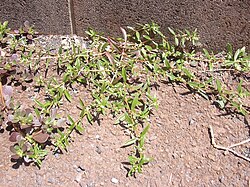| Oldenlandia | |
|---|---|
 | |
| Oldenlandia corymbosa | |
| Scientific classification | |
| Kingdom: | Plantae |
| Clade: | Tracheophytes |
| Clade: | Angiosperms |
| Clade: | Eudicots |
| Clade: | Asterids |
| Order: | Gentianales |
| Family: | Rubiaceae |
| Subfamily: | Rubioideae |
| Tribe: | Spermacoceae |
| Genus: | Oldenlandia L. (1753) |
| Type species | |
| Oldenlandia corymbosa Linnaeus | |
| Species | |
Many, see text | |
| Synonyms [1] | |
| |
Oldenlandia is a genus of flowering plants in the family Rubiaceae. It is pantropical in distribution and has about 240 species. [2] [3] The type species for the genus is Oldenlandia corymbosa . [4]
Contents
Oldenlandia was named by Linnaeus in 1753 in Species Plantarum. [5] The name honors the Danish botanist Henrik Bernard Oldenland (c. 1663 –1697). [6] Some species are important in ethnomedicine; a number (usually island endemics) are threatened species, with one species and one variety being completely extinct already.
Some botanists have not recognized Oldenlandia, but have placed some or all of its species in a broadly defined Hedyotis . [7] More recently, the circumscription of Hedyotis has been narrowed to a monophyletic group of about 115 species and no longer includes Oldenlandia. [8] The genus Oldenlandia, as presently defined, is several times polyphyletic and will eventually be reduced to a group of species closely related to the type species. This group, known informally as Oldenlandia sensu stricto, is sister to a section of Kohautia that will eventually be separated from Kohautia and named as a new genus. [8]